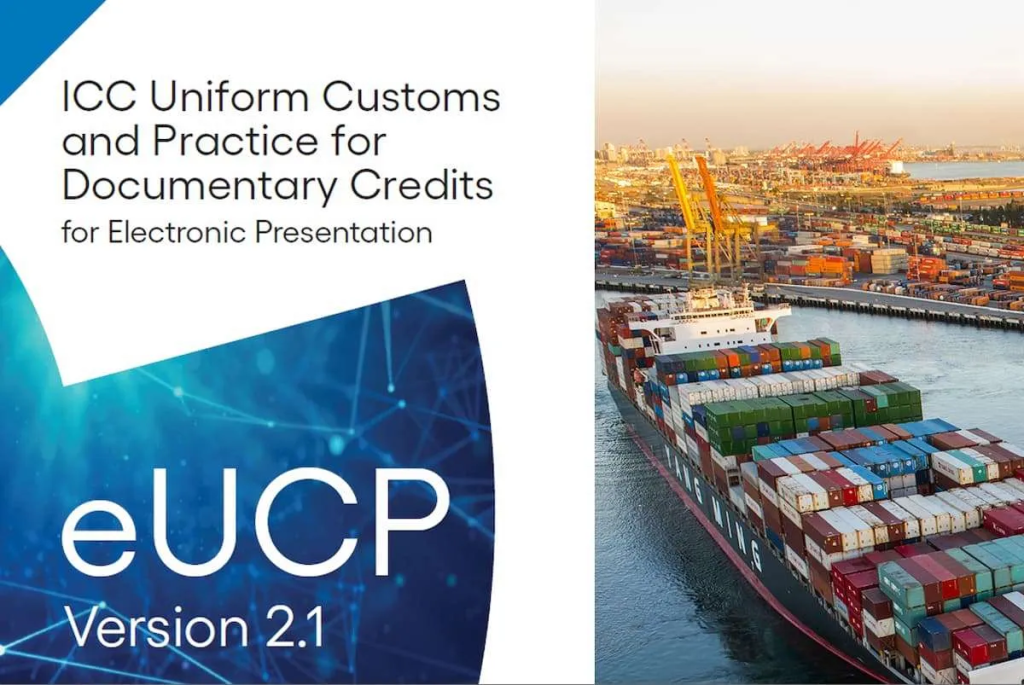UCP 600 and Letters of Credit | Trade Finance Global 2025 Guide

Access trade, receivables and supply chain finance
We assist companies to access trade and receivables finance through our relationships with 270+ banks, funds and alternative finance houses.
Get Started
ADVERTISEMENT
Contents
UCP 600 (Uniform Customs & Practice for Documentary Credits)
The Uniform Customs & Practice for Documentary Credits (UCP 600) is a set of rules agreed by the International Chamber of Commerce, which apply to finance institutions which issue Letters of Credit – financial instruments helping companies finance trade. Many banks and lenders are subject to this regulation, which aims to standardise international trade, reduce the risks of trading goods and services, and govern trade.
What does UCP 600 mean?
The UCP 600 (“Uniform Customs & Practice for Documentary Credits”) is a set of rules issued by the International Chamber of Commerce (ICC) which governs the use of Letters of Credit. The UCP are the most successful private rules for trade ever developed: the UCP 600’s 39 articles apply to 175 countries around the world, governing some $1 trillion USD of trade per year.
The UCP 600 rules do not hold legal force in any country, but apply to Letters of Credit almost anywhere in the world, and must be incorporated by express reference in them.
What is UCP 600 used for?
The UCP 600 is used to standardise the rules governing Letters of Credit to standardise transactions and benefit all parties. The rules were created by industry experts, and are mandated by the ICC Banking Commission rather than through legislation. This means that the same set of rules are applicable in the same way in nearly every country.
The first UCP was created in 1933 and has been revised periodically by the ICC. The UCP 600 is the latest version of the rules governing letters of credit; a supplement, the eUCP, was published in 2019 to govern electronic transactions.
Is UCP 600 legally binding?
The UCP 600 rules are voluntarily incorporated into contracts and have to be specifically outlined in trade finance contracts in order to apply. They also allow some flexibility for the international parties involved.
An accompaniment to the UCP 600 is the International Standard Banking Practice for the Examination of Documents under Documentary Credits (ISBP), ICC Publication 745. This helps with understanding whether a document complies with the terms of Letters of Credit.
Does UCP 600 require strict compliance?
As a rule, Letters of Credit require strict compliance – meaning both parties must stick to all the formal terms of the contract or risk being found in breach of contract. Under UCP 600, documents must be in strict compliance with the terms of the contract, so any inaccuracies may risk jeopardising the transactions.
However, in practice, standards have relaxed somewhat under UCP 600, meaning that trivial issues or minor discrepancies between documents may be overlooked.
Credits that are issued and governed by UCP 600 will be interpreted in line with the entire set of 39 articles contained in UCP 600. However, exceptions to the rules can be made by express modification or exclusion.
The UCP 600 are the most successful rules ever developed in relation to trade and most Letters of Credit are subject to them.
What is the difference between UCP 500 and UCP 600?
UCP 600 get their name from the publication in which they were released, ICC Publication No. 600, so the current version of the rules are commonly referred to as UCP 600. These replaced UCP 500 on the 1st July 2007.
UCP 600 differs from UCP 500, which was introduced on 1 January 1994, in several key ways:
- Number of articles: UCP 600’s 39 articles are fewer than UCP 500’s 49, making for a more concise and easily usable document
- Simpler and clearer language: UCP 600 has introduced more simply worded provisions to facilitate understanding and improve clarity
- New terminology introduced: Article 2 of UCP 600 now defines several key terms, removing ambiguity
- Clarity on compliance issues: UCP 600 specifies which discrepancies in documents may be overlooked, sometimes relaxing compliance standards (for example, removing the need for all addresses of the beneficiary to be identical as long as they are in the same country).
- this was done to reduce the number of rejections of documents, especially for trivial errors
- Reorganisation and cosmetic changes
Part 1 – What is a Letter of Credit and what are the benefits to its users?
Summary of the UCP 600
Here are a few of the key elements which make up the UCP 600:
- Definition of key terms which are prevalent in international trade (e.g. honouring [of payments], applicants, banking days, presentation)
- How international trade documents (Letters of Credit) can be signed and acknowledged by all parties
- The difference between documents, goods and services (and which parties deal with these)
- Which parts of a Letter of Credit are negotiable and non-negotiable
- How credit works, and how payment is made
- How banks can communicate the confirmation of goods (teletransmission)
- Transportation of the goods, modes of transport, and who bears responsibility
- How to deal with discrepancies, waivers and giving notice
- The provision of original documents or electronic copies
- Bills of Lading
- Insurance and covering the cost of goods
- Loss of shipping documents in transit
How many articles are in UCP 600?
The UCP 600 is made up of 39 articles. Its structure is the following:
- Articles 1 – 5 – General Provisions and Definitions
- Articles 6 – 13 – Liabilities and Responsibilities
- Article 14 – Examination of Documents
- Articles 15 – 17 – Examination of Documents
- Articles 18 – 28 – Documents
- Articles 29 – 33 – Miscellaneous Provisions
- Articles 34 – 37 – Disclaimers
- Articles 38 – 39 – Transferable Credit & Assignment
Part 2 – Explanation of the UCP 600 rules and history of UCP
Will the UCP 600 be revised?
Since the last version of the UCP, UCP 600, was published in 2007 – nearly 30 years ago – many have wondered when the rules will be updated next.
For now, however, the ICC seems to have no intention of updating or changing the rules. This is because an update to the UCP is time and labour-intensive and very complicated to organise, and many feel it is not necessary yet:
- To create the UCP 600, a consulting group was established with 41 members from 26 countries; the first draft of the rules received over 5000 comments which were all reviewed before drafting the final version
- UCP 600 is doing relatively well and works most of the time; there have only been a few disputes, usually centred around ambiguous wording that could not be agreed to when the UCP 600 was drafted;
Any revision to the UCP 600 might introduce uncertainty in the industry:
- The ICC would need to decide who would draft a first version of the revised rules, considering who has the expertise to do so
- This revision would take time and be at a high cost
- There is already regulatory uncertainty in the market, so policy would need to be drafted before any advancement of the documents
- It is unclear what would happen to the sanctions currently in the market with the new rules
Even in the event of a revision, no version will ever be perfect: there will always need to be compromise, as the rules cover over 150 trading countries and needs to reflect the commercial and legal realities of trade.
However, the eUCP, which govern electronic transactions, are updated more frequently to reflect the changes in technology and practices of electronic documentation. The eUCP’s latest version, eUCP Version 2.1, came into effect in 2019, and covers digital trade documents and transactions.
Part 3 – Evolution of UCP 600 rules – will we see UCP 700 rules?
Trade Finance Global interviewed Pradeep Taneja, Managing Director of Taneja Global Trade Consulting, Bahrain and Co-Chairman and Board member of ICC Bahrain to learn more about Letters of Credit. To read this interview, click here.
Electronic UCP (eUCP)
In 2019, the International Chamber of Commerce also released an updated supplement for the electronic rules (eRules) of the Uniform Customs & Practice for Documentary Credits. TFG covered the key changes for V2.0 of the eUCP rules, which can be found here.

Difference between the UCP 600 and the ISP98
The ISP98 (International Standby Practices) are 89 rules that specifically govern the use of Standby Letters of Credit.
Both the USP 600 and the ISP98 are documents released by the ICC; however, the ISP98 describe the rules for Standby Letters of Credit more precisely than the USP 600, where they are only briefly mentioned. There are also substantive differences between the ways Standby Letters of Credit are treated in the UCP 600 and in the ISP98.
For example:
- ISP98 Rule 2.02 identifies an issuer’s officer or other branch as a separate person, while the UCP 600 identifies a branch in another country as a separate entity
- ISP98 Rule provides beneficiaries the opportunity to present documents to a bank after a closure due to force majeure; the UCP 600 do not provide for this
- The UCP 600 require examiners to compare documents they are given to identify any inconsistencies; ISP98 Rule 4.03 explicitly does not require this
Part 4 – 3 tips for using UCP 600 rules in Letters of Credit
What about the eUCP
Recently, the ICC updated eUCP 600 rules (eRules), to accelerate the digitilisation of trade finance. Trade Finance Global have published the updates on the eRules for ‘eUCP 600’, which are supplementary rules to these UCP 600 rules.
Find out moreOur trade finance partners
- Letters of Credit / Documentary Credit Resources
- All Letters of Credit Topics
- Podcasts
- Videos
- Conferences




















